New Perspectives in Landslide Displacement Detection Using Sentinel-1 Datasets
Abstract
1. Introduction
2. Study Area
3. Materials and Methods
3.1. Interferometric Point Target Analysis
3.2. DInSAR Analysis
- phrate is the phase linear rate,
- var(phrate) is the variance of phase linear rate,
- N is the number of interferograms (in this case 6),
- t is the time interval,
- ϕ is the differential interferometric phase,
- λ is the signal wavelength.
4. Results
5. Discussion
- dLOS: is the cumulated displacement along the LOS,
- is the cumulated displacement along east coordinate,
- is the cumulated displacement along north coordinate,
- is the cumulated displacement along the vertical direction,
- φ is the sensor look angle,
- θ is the azimuth direction.
- LOSrate is the rate of deformation along the LOS,
- t is the time elapsed between the first and last GNSS measurement expressed in days.
6. Conclusions
- Detection: where and when deformation occurred (or is occurring);
- Assessment of the deformation;
- Evolution (past and future) of the deformation.
Author Contributions
Funding
Acknowledgments
Conflicts of Interest
References
- Massonnet, D.; Rossi, M.; Carmona, C.; Adragna, F.; Peltzer, G.; Feigl, K.; Rabaute, T. The displacement field of the Landers earthquake mapped by radar interferometry. Nature 1993, 364, 138–142. [Google Scholar] [CrossRef]
- Massonnet, D.; Feigl, K.L. Radar interferometry and its application to changes in the Earth’s surface. Rev. Geophys. 1998, 36, 441–500. [Google Scholar] [CrossRef]
- Ouchi, K. Recent Trend and Advance of Synthetic Aperture Radar with Selected Topics. Remote Sens. 2013, 5, 716–807. [Google Scholar] [CrossRef]
- Ferretti, A.; Prati, C.; Rocca, F. Permanent scatterers in SAR interferometry. IEEE Trans. Geosci. Remote Sens. 2001, 39, 8–20. [Google Scholar] [CrossRef]
- Berardino, P.; Fornaro, G.; Lanari, R.; Sansosti, E. A new algorithm for surface deformation monitoring based on small baseline differential SAR interferograms. IEEE Trans. Geosci. Remote Sens. 2002, 40, 2375–2383. [Google Scholar] [CrossRef]
- Colesanti, C.; Ferretti, A.; Prati, C.; Rocca, F. Monitoring landslides and tectonic motions with the Permanent Scatterers Technique. Eng. Geol. 2003, 68, 3–14. [Google Scholar] [CrossRef]
- Raucoules, D.; Colesanti, C.; Carnec, C. Use of SAR interferometry for detecting and assessing ground subsidence. C. R. Geosci. 2007, 339, 289–302. [Google Scholar] [CrossRef]
- Cigna, F.; Bianchini, S.; Casagli, N. How to assess landslide activity and intensity with Persistent Scatterer Interferometry (PSI): The PSI-based matrix approach. Landslides 2013, 10, 267–283. [Google Scholar] [CrossRef]
- Colesanti, C.; Wasowski, J. Investigating landslides with space-borne Synthetic Aperture Radar (SAR) interferometry. Eng. Geol. 2006, 88, 173–199. [Google Scholar] [CrossRef]
- Cruden, D.M.; Varnes, D.J. Landslide Types and Processes. Spec. Rep. Natl. Acad. Sci. Transp. Res. Board 1996, 247, 36–75. [Google Scholar]
- Bovenga, F.; Wasowski, J.; Nitti, D.O.; Nutricato, R.; Chiaradia, M.T. Using COSMO/SkyMed X-band and ENVISAT C-band SAR interferometry for landslide analysis. Remote Sens. Environ. 2012, 119, 272–285. [Google Scholar] [CrossRef]
- Herrera, G.; Gutiérrez, F.; García-Davalillo, J.C.; Guerrero, J.; Notti, D.; Galve, J.P.; Fernández-Merodo, J.A.; Cooksley, G. Multi-sensor advanced DInSAR monitoring of very slow landslides: The Tena Valley case study (Central Spanish Pyrenees). Remote Sens. Environ. 2013, 128, 31–43. [Google Scholar] [CrossRef]
- Tofani, V.; Raspini, F.; Catani, F.; Casagli, N. Persistent Scatterer Interferometry (PSI) Technique for Landslide Characterization and Monitoring. Remote Sens. 2013, 5, 1045–1065. [Google Scholar] [CrossRef]
- Mantovani, M.; Devoto, S.; Piacentini, D.; Prampolini, M.; Soldati, S.; Pasuto, A. Advanced SAR Interferometric Analysis to Support Geomorphological Interpretation of Slow-Moving Coastal Landslides (Malta, Mediterranean Sea). Remote Sens. 2016, 8, 443. [Google Scholar] [CrossRef]
- Necula, N.; Niculițua, M.; Tessari, G.; Floris, M. InSAR analysis of Sentinel-1 data for monitoring landslide displacement of the north-eastern Copou hillslope, Iași city, Romania. In Proceedings of the Romanian Geomorphology Symposium, Iasi, Romania, 11 May 2017; Volume 1, pp. 85–88. [Google Scholar]
- Barra, A.; Monserrat, O.; Crosetto, M.; Cuevas-Gonzalez, M.; Devanthéry, N.; Luzi, G.; Crippa, B. Sentinel-1 Data Analysis for Landslide Detection and Mapping: First Experiences in Italy and Spain. In Proceedings of the Workshop on World Landslide Forum, Ljubljana, Slovenia, 29 May–2 June 2017. [Google Scholar]
- Panizza, M.; Pasuto, A.; Silvano, S.; Soldati, M. Temporal occurrence and activity of landslides in the area of Cortina d’Ampezzo (Dolomites, Italy). Geomorphology 1996, 15, 311–326. [Google Scholar] [CrossRef]
- Pasuto, A.; Soldati, M. Some cases of deep-seated gravitational deformations in the area of Cortina d’Ampezzo (Dolomites). Implications in environmental assessment. In Implications in Environmental Risk Assessment European Experimental Course on Applied Geomorphology; Panizza, M., Soldati, M., Coltellacci, M., Eds.; Istituto di Geologia—Università degli Studi: Modena, Italy, 1991; pp. 91–104. [Google Scholar]
- Pasuto, A.; Soldati, M. The use of landslide units in geomorphological mapping: An example in the Italian Dolomites. Geomorphology 1999, 30, 53–64. [Google Scholar] [CrossRef]
- Soldati, M.; Corsini, A.; Pasuto, A. Landslides and climate change in the Italian Dolomites since the Late glacial. Catena 2004, 55, 141–161. [Google Scholar] [CrossRef]
- Panizza, M. Glacio pressure implications in the production of landslides in the Dolomitic area. Geol. Appl. Idrogeol. 1973, 8, 289–297. [Google Scholar]
- Vandelli, V.; Ghinoi, A.; Marchetti, M.; Soldati, M. Discovery and dating of Pre-LGM deposits in a high catchment of the Dolomites (Italy): New insights on climate-related geomorphological processes during the Late Pleistocene. Geomorphology 2019, 332, 22–32. [Google Scholar] [CrossRef]
- Borgatti, L.; Soldati, M. Landslides as a geomorphological proxy for climate change: A record from the Dolomites (northern Italy). Geomorphology 2010, 120, 56–64. [Google Scholar] [CrossRef]
- Angeli, M.-G.; Pasuto, A.; Silvano, S. Towards the definition of slope instability behaviour in the Alverà mudslide (Cortina d’Ampezzo, Italy). Geomorphology 1999, 30, 201–211. [Google Scholar] [CrossRef]
- Bossi, G.; Borgatti, L.; Gottardi, G.; Marcato, G. Quantification of the uncertainty in the modelling of unstable slopes displaying marked soil heterogeneity. Landslides 2019, 1–12. [Google Scholar] [CrossRef]
- Bossi, G.; Mantovani, M.; Frigerio, S.; Schenato, L.; Marcato, G.; Pasuto, A. A monitoring network to map and assess landslide activity in a highly anthropized area. Geosciences 2016, 6, 40. [Google Scholar] [CrossRef]
- Geudtner, D.; Torres, R.; Snoeij, P.; Davidson, M.; Rommen, B. Sentinel-1 System capabilities and applications. In Proceedings of the 2014 IEEE Geoscience and Remote Sensing Symposium, Quebec City, QC, Canada, 13–18 July 2014; pp. 1457–1460. [Google Scholar]
- Lanari, R.; Berardino, P.; Bonano, M.; Casu, F.; De Luca, C.; Elefante, S.; Fusco, A.; Manunta, M.; Manzo, M.; Ojha, C.; et al. Sentinel-1 results: SBAS-DInSAR processing chain developments and land subsidence analysis. In Proceedings of the 2015 IEEE International Geoscience and Remote Sensing Symposium (IGARSS), Milan, Italy, 26–31 July 2015; pp. 2836–2839. [Google Scholar]
- Rabus, B.; Eineder, M.; Roth, A.; Bamler, R. The shuttle radar topography mission—A new class of digital elevation models acquired by spaceborne radar. ISPRS J. Photogramm. Remote Sens. 2003, 57, 241–262. [Google Scholar] [CrossRef]
- Werner, C.; Wegmuller, U.; Strozzi, T.; Wiesmann, A. Interferometric point target analysis for deformation mapping. In Proceedings of the 2003 IEEE International Geoscience and Remote Sensing Symposium, Toulouse, France, 21–25 July 2003; Volume 7, pp. 4362–4364. [Google Scholar]
- Costantini, M. A novel phase unwrapping method based on network programming. IEEE Trans. Geosci. Remote Sens. 1998, 36, 813–821. [Google Scholar] [CrossRef]
- Borgatti, L.; Soldati, M. Landslides and climatic change. In Geomorphological Hazards and Disaster Prevention; Alcantara-Ayala, I., Goudie, A.S., Eds.; Cambridge University Press: Cambridge, UK, 2010; pp. 87–96. [Google Scholar]

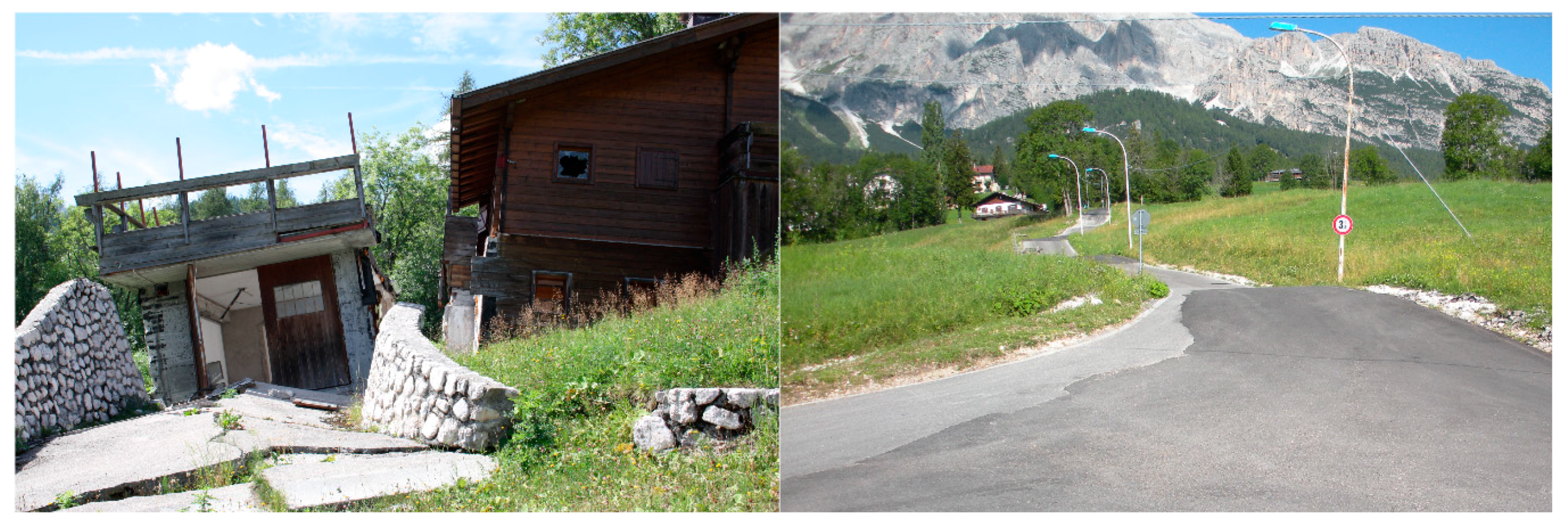
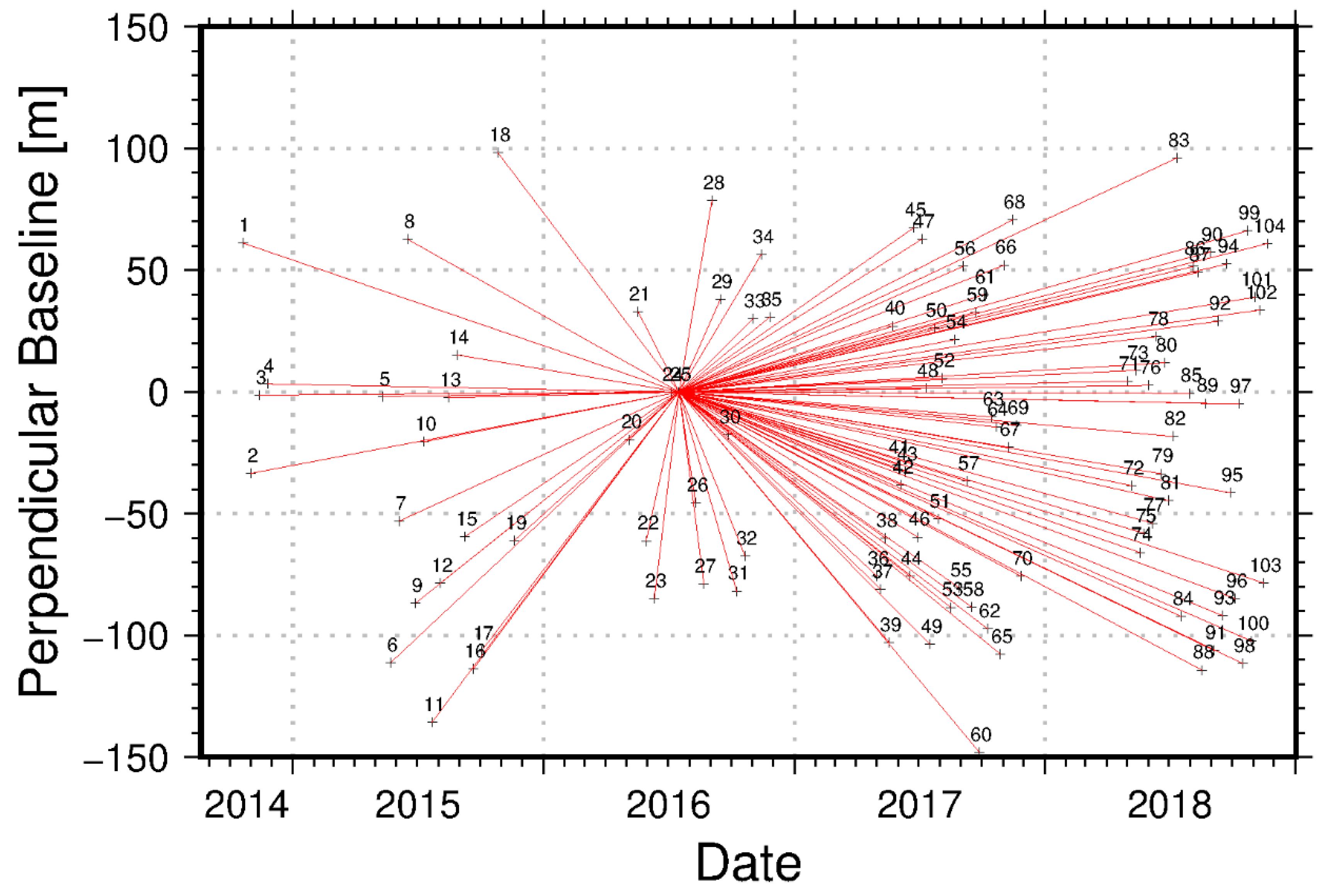
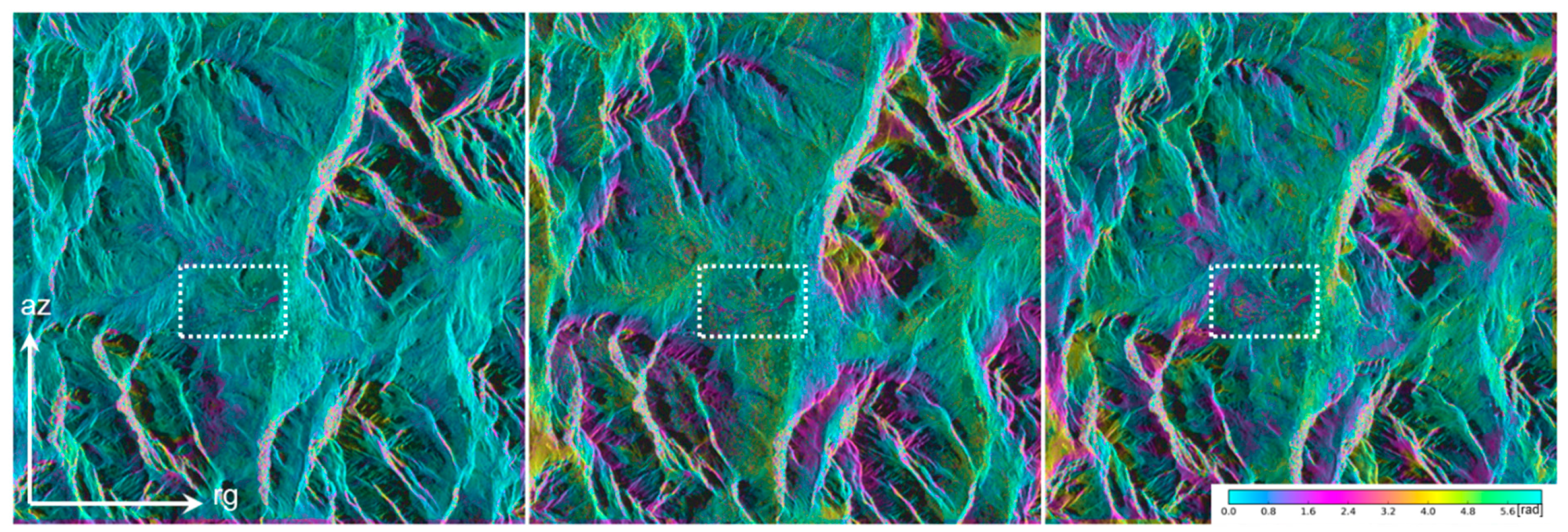
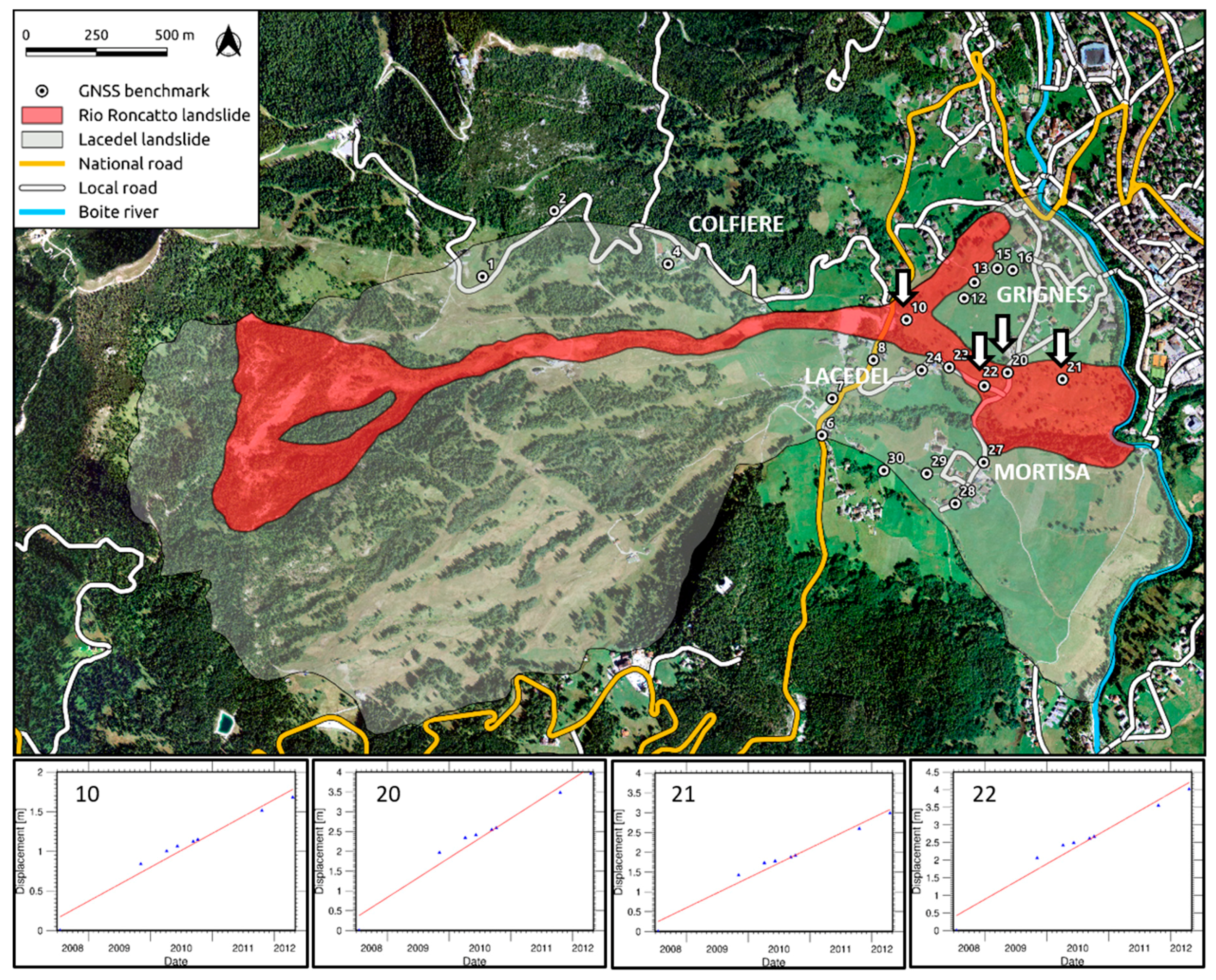
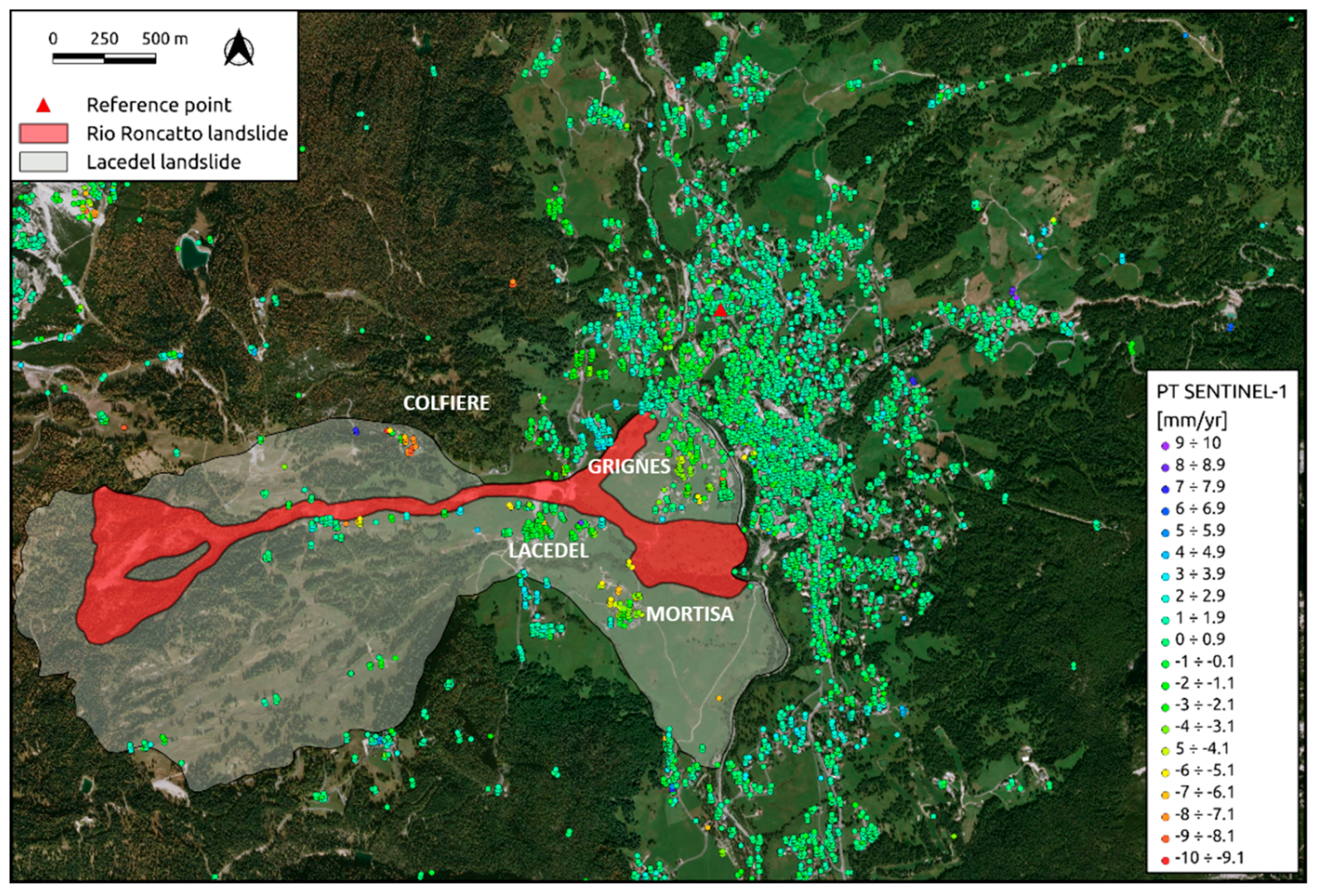
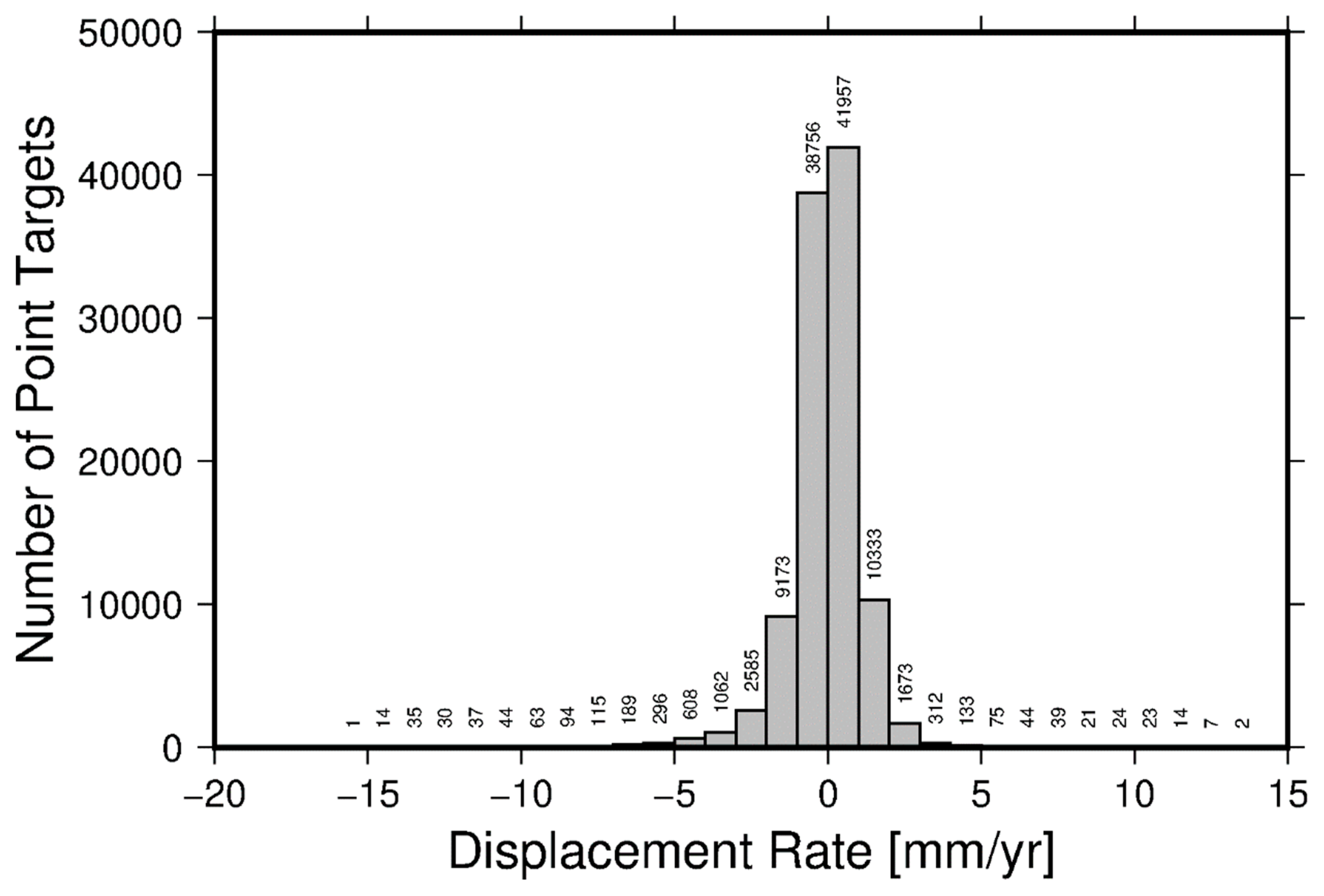
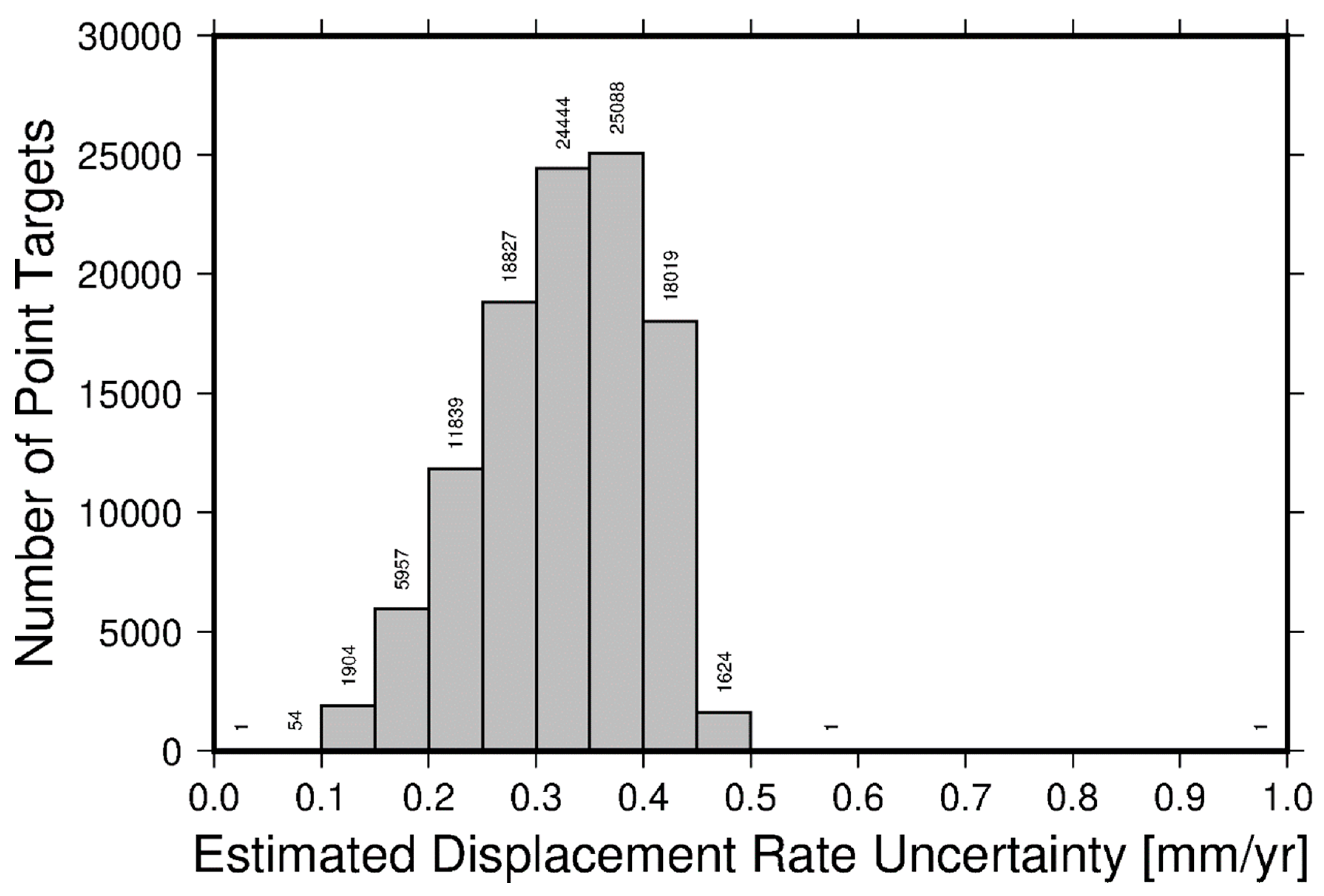
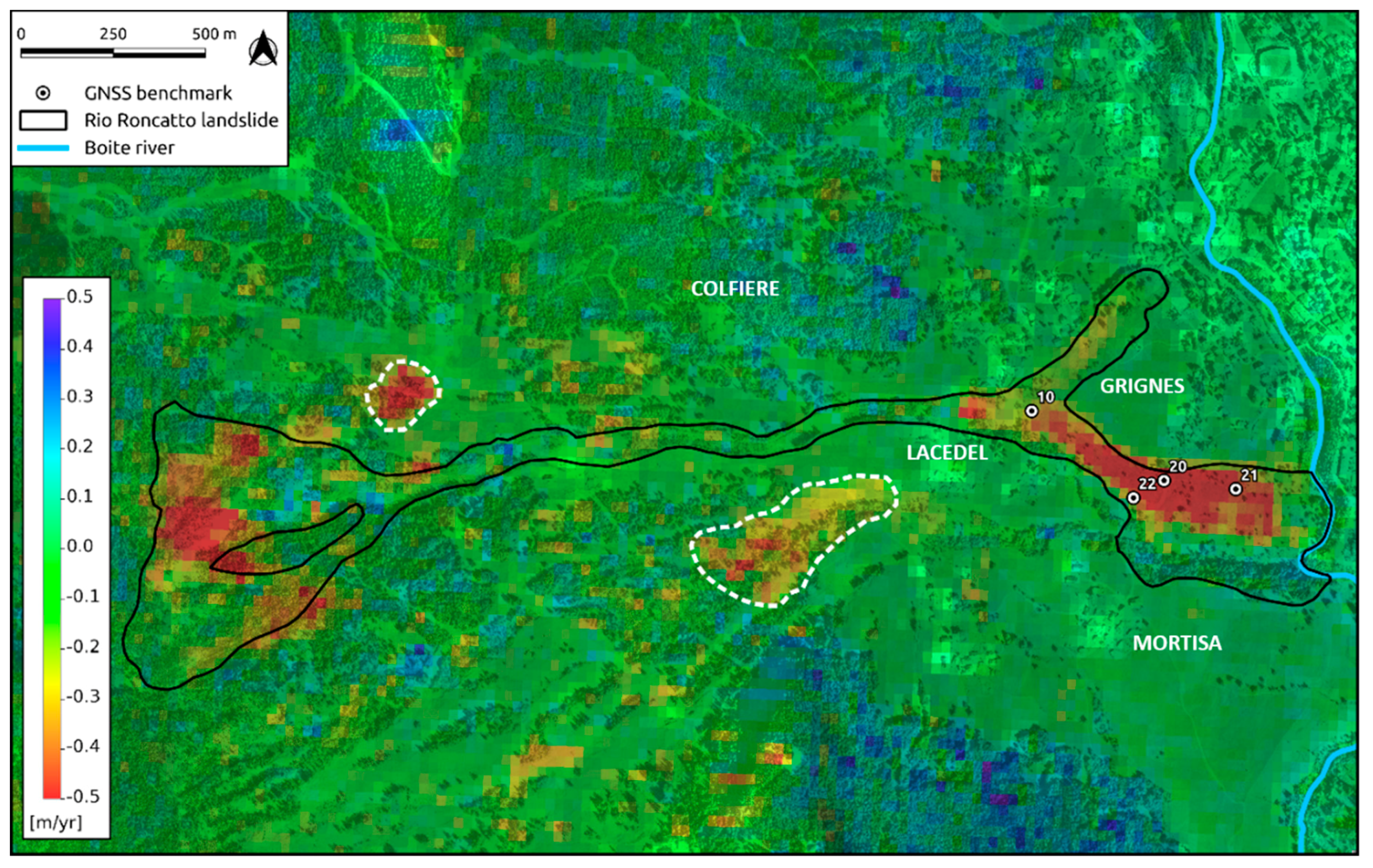
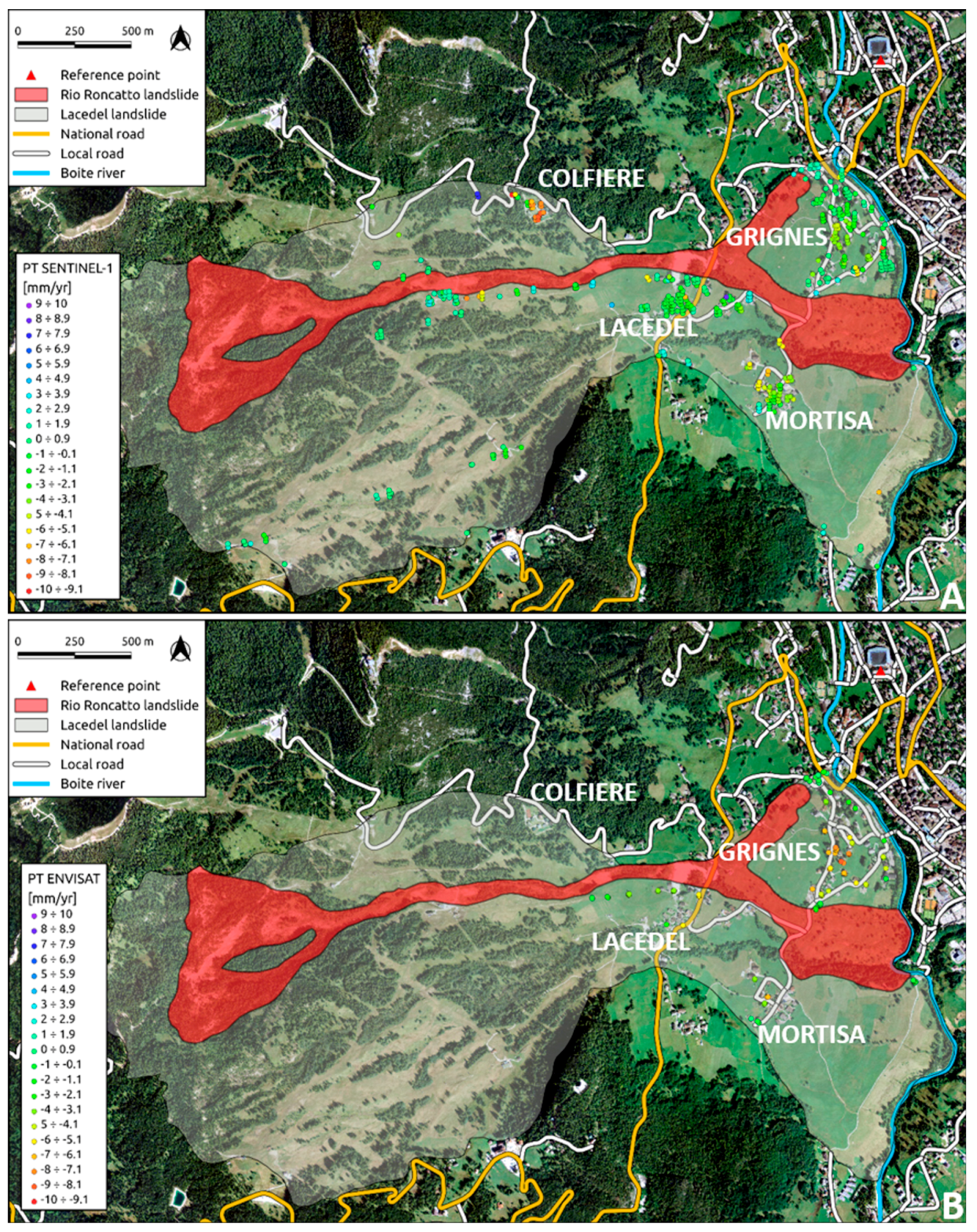
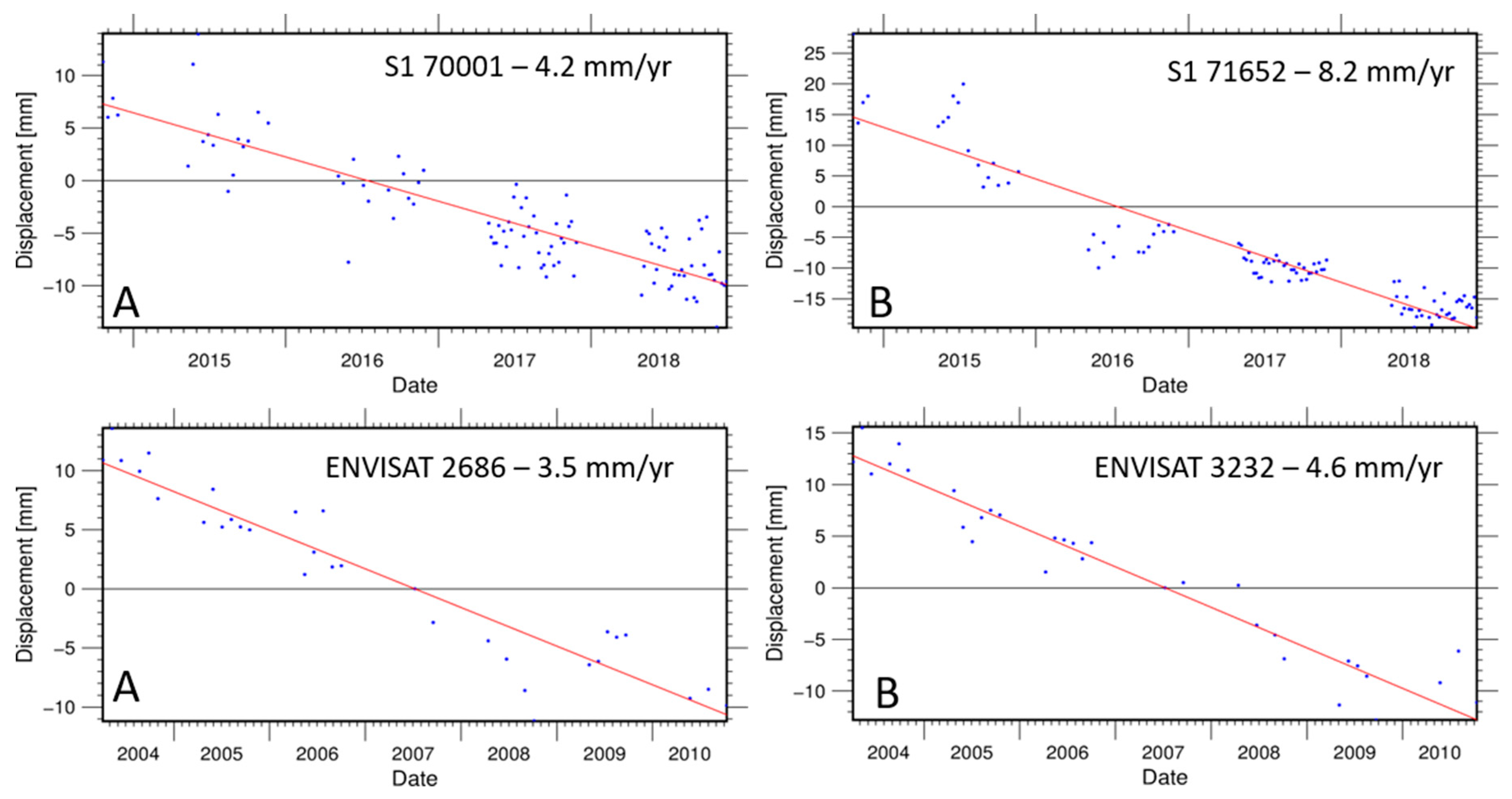
| Velocity class | Description | Typical velocity |
|---|---|---|
| 7 | Extremely rapid | 5 m/s |
| 6 | Very rapid | 3 m/min |
| 5 | Rapid | 1.8 m/h |
| 4 | Moderate | 13 m/month |
| 3 | Slow | 1.6 m/year |
| 2 | Very slow | 16 mm/year |
| 1 | Extremely slow |
| Launch date | 3 April 2014 (A), 25 April 2016 (B) | |||
| Lifetime | 7 years with consumable for 12 years | |||
| Orbit type | near polar, sun-synchronized | |||
| Orbit altitude | 697 km | |||
| Orbit repeat cycle | 12 days, 6 days (A+B) | |||
| Orbit deviation tube (RMS) | +/- 50 m | |||
| SAR frequency | 5.4 GHz | |||
| Incidence angle range | 20°–45° | |||
| Acquisition mode | SM | IW | EW | WV |
| Swath width | 80 km | 250 km | 400 km | 20 km |
| Geometric resolution [rg x az] | 1.7x4.3 to 3.6x4.9 m | 2.7x22 to 3.5x22 m | 7.9x43 to 15x43 m | 2.0x4.8 to 3.1x4.8 m |
| Pixel spacing [rg x az] | 1.5x3.6 to 3.1x4.1 m | 2.3x14.1 m | 5.9x19.9 m | 1.7x4.1 to 2.7x4.1 m |
| TRACK | ORBIT | θ [deg] | φ [deg] | t [days] | |
| 44 | A | -10.9014 | 33.7318 | 1368 | |
| GNSS ID. | dE [m] | dN [m] | dH [m] | dLOS [m] | GNSS-LOS rate [m/yr] |
| 10 | 1.667 | -0.183 | -0.112 | 0.991 | 0.264 |
| 20 | 3.811 | -0.783 | -0.760 | 2.628 | 0.701 |
| 21 | 2.936 | -0.345 | -0.537 | 2.011 | 0.537 |
| 22 | 2.670 | -2.871 | -0.853 | 1.864 | 0.497 |
| Geographic Coordinates | Range-Doppler Coordinates | |||||
|---|---|---|---|---|---|---|
| GNSS ID. | Lon. [deg.] | Lat. [deg.] | H. [m] | Ra [pix] | Az [pix] | LOS rate [m/yr] |
| 10 | 12.124824 | 46.535908 | 1355 | 2892 | 695 | 0.197 |
| 20 | 12.129589 | 46.534332 | 1286 | 2993 | 678 | 0.546 |
| 21 | 12.132136 | 46.534185 | 1259 | 3047 | 674 | 0.520 |
| 22 | 12.128531 | 46.533881 | 1297 | 2969 | 676 | 0.439 |
© 2019 by the authors. Licensee MDPI, Basel, Switzerland. This article is an open access article distributed under the terms and conditions of the Creative Commons Attribution (CC BY) license (http://creativecommons.org/licenses/by/4.0/).
Share and Cite
Mantovani, M.; Bossi, G.; Marcato, G.; Schenato, L.; Tedesco, G.; Titti, G.; Pasuto, A. New Perspectives in Landslide Displacement Detection Using Sentinel-1 Datasets. Remote Sens. 2019, 11, 2135. https://doi.org/10.3390/rs11182135
Mantovani M, Bossi G, Marcato G, Schenato L, Tedesco G, Titti G, Pasuto A. New Perspectives in Landslide Displacement Detection Using Sentinel-1 Datasets. Remote Sensing. 2019; 11(18):2135. https://doi.org/10.3390/rs11182135
Chicago/Turabian StyleMantovani, Matteo, Giulia Bossi, Gianluca Marcato, Luca Schenato, Giacomo Tedesco, Giacomo Titti, and Alessandro Pasuto. 2019. "New Perspectives in Landslide Displacement Detection Using Sentinel-1 Datasets" Remote Sensing 11, no. 18: 2135. https://doi.org/10.3390/rs11182135
APA StyleMantovani, M., Bossi, G., Marcato, G., Schenato, L., Tedesco, G., Titti, G., & Pasuto, A. (2019). New Perspectives in Landslide Displacement Detection Using Sentinel-1 Datasets. Remote Sensing, 11(18), 2135. https://doi.org/10.3390/rs11182135









